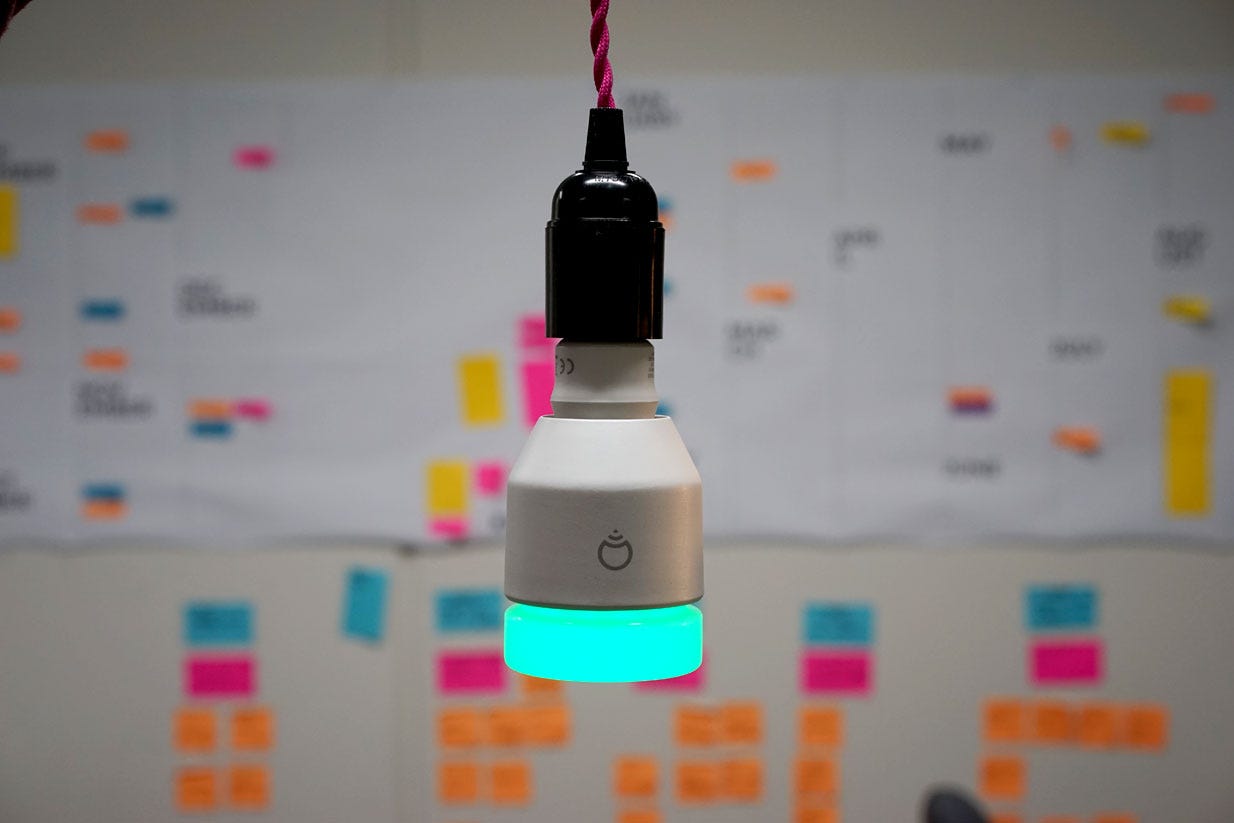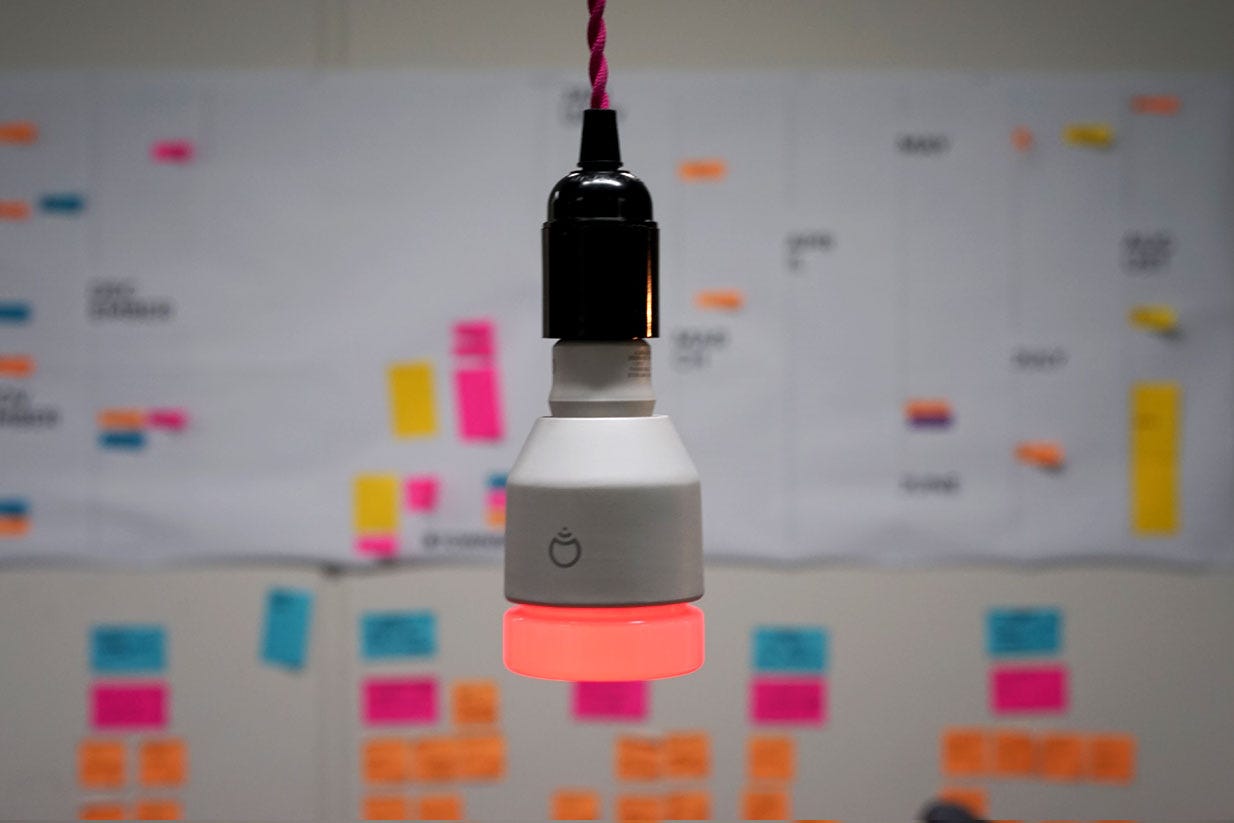Guest contributor Daniel Clark shares his experience with using LIFX to increase workplace effectiveness.
Part of our culture at Rushfaster is to focus on effectiveness. This is why we can operate with such a small close-knit team. Recently we’ve started looking at “the internet of things” to help us become more effective. As unlikely as it sounds, we realised that smart lighting could actually really help us achieve more from each day.
So, “The internet of things” is a major tech focus point right now, and for good reason — getting things connected to the internet is super cool, but, as it turns out, it’s also sometimes a bit gimmicky. The good news is that I think a lot of people are getting over the novelty of smart devices and are now ready to understand the new possibilities they open up for improving our lives. During this phase of TIOT I think we’ll see the rather ridiculous smart devices (think smart water bottles and spoons) fade away and the useful devices will be here to stay. Useful devices like LIFX lightbulbs.
A LIFX bulb is an LED bulb that’s connected to the net. It’s controlled by your phone, watch or light switch. You can turn the lights on and off, change the colour, effect and brightness. Neat. But the real power kicks in when you connect your new lights to IFTTT. IFTTT stands for “if this then that” so for example “IF you arrive home THEN your lights will turn on”. Super neat!
We put LIFX bulbs to the test to try to increase our effectiveness. To do this, we installed LIFX bulbs at work and at home. Then we set up some IFTTT recipes for automation. Now that we had our LIFXs set up, and our IFTTT on, here’s what we did…
Morning
Being effective starts from the moment you get up, and that’s exactly when LIFX kicks in. Instead of starting the day with an alarm, it’s super easy to now wake up with light… it mimics nature, and it’s a beautiful feeling. At 6.30 am we set our lights to fade on over 15 minutes with sunrise hues. These lights are mighty powerful and when they’re sitting right next to your bed, they make the best start to the day as the light starts sending a message to your body that it’s time to wake up. To make this even more blissful, we also used IFTTT to turn on our Sonos. You haven’t experiences a wakeup sequence like this before.
Getting up early allows us to use our more productive hours of the day, whilst our brains are more alert. On top of this, you feel like you’re getting stuff done before everyone else — so you feel more pro-active.

In the office
The environment you’re in makes a huge difference to your ability to be effective. For us, we need to create an environment that allows our team to knock tasks out. There are many things that we do to achieve this, but here are some of the main ways:
1. We minimise interruptions — A big part of improving effectiveness is to minimise the interruptions that each team member receives daily. Did you know that every time you’re interrupted, it takes you another 5–10 minutes to get back into the task that you’re working on. So you only need a few interruptions to occur during an hour and you’ve lost half of it.
2. Maximise team throughput during “magic hours” — We believe that there are key times of the day when we are most able to concentrate, we call those hours our ‘magic hours’. This is the time of day that everyone is fresh, alert and can push through their big project work. The magic hours at Rushfaster are between 9.30am and 12 midday each day.
3. Magic hours + no interruptions = “focused work block” — When both these combine for a few hours, the effectiveness of our team skyrockets.
So to help support these values, we set up LIFX bulbs throughout the office so that they were clearly visible to everyone in the team. The purpose of these lights weren’t to light the room, rather it was to indicate when the team was in a focused work block. We set our LIFX to turn either green or red at certain times. Green means business as usual, Red means the whole team is in a focused work block — this means no interruptions, it’s time to just get stuff done.

Every day at 9.30am the lights change from green to red via IFTTT, then they change from red to green at 12. That’s 2.5 hours of solid focused work and it makes such a difference to what everyone can achieve. It’s reduced overtime and stress whilst boosting output. This is huge for us, we love it!

In the evening
Although it doesn’t really increase our effectiveness, a really nice to have feature is setting up our lights to turn on when we arrive home. This is done via the GPS in our phones. As you get close, the lights start fading on and when you open the door everything is ready and waiting for you. This makes your house warm and welcoming, it makes you happy. It’s like mum is home and she’s ready to make you dinner, although she’s not — but your lights are on.
You get used to this very quickly!

At night
Now this is all great in theory, but in order to keep this up, it’s really important you get enough sleep. The key to getting up early, and keeping this going, is getting to bed at the right time — this is usually where you break the chain.
To combat this, we set our lights to flash and start dimming at a certain time each night — the dimming sequence takes about 30 minutes which is about enough time to finish up and prepare for sleep. In the bedroom we set up a group of lights to set an environment designed to make us sleepy. The lighting is darker with warmer hues and the lights fade out slowly, representing a sunset. You can’t help but sleep.
So… what happened?
Having ‘smart’ internet connected devices at home is pretty fun, but using them to solve real problems is where the money really pays off. We found that once we got used to this system, we saw big increases in effectiveness, the team was happier because we were well rested and had block-out periods to just power through work. And when you get on a roll of completing task after task after task, you get a great feeling of accomplishment and this spurs you on further. I don’t think we’ll be going back.
You wouldn’t think it, but a simple thing like connecting our lights to the internet made such a difference to our lives (work and home). When you think about the productivity improvements we’ve made, we’ve very quickly paid for the cost of the lights and we’re already reaping the benefits, all of us.
Daniel Clark is an entrepreneur & co-founder of townske.com, rushfaster.com.au. Entrepreneurship, customer experience, disruption, the environment and electronic music.
